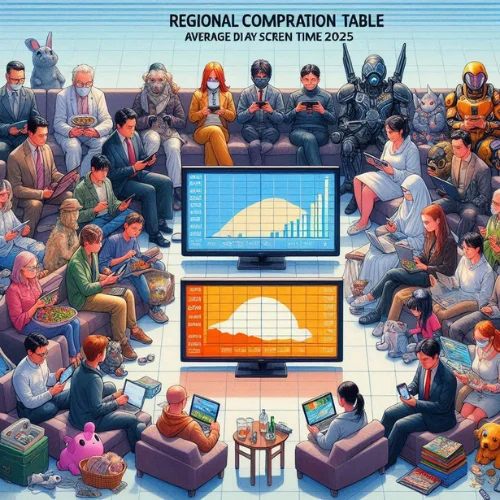Revealing Average Screen Time Statistics: How Much Is Too Much in 2025?
Screens fill our workdays, shape our social lives, and entertain us long after sunset. Whether it is the glow of a smartphone, the glare of a laptop, or the lure of late‑night streaming, screen exposure is now a defining habit of modern life. But how many hours do people actually spend staring at screens, and what does that mean for health, productivity, and happiness? This in‑depth, data‑driven guide reveals the latest average screen time statistics, compares regions and age groups, examines five‑year trends, and supplies practical tips you can act on today.
Table of Contents
- What Counts as “Screen Time”?
- Global Average Screen Time in 2025
- Screen Time by Age Group
- Screen Time by Device Type
- Five‑Year Trend Analysis (2020 – 2025)
- Pros and Cons of Current Screen Time Levels
- Healthy Screen Time Guidelines and Expert Advice
- Frequently Asked Questions
- Conclusion and Call to Action
1. What Counts as “Screen Time”?

The term screen time refers to any period spent looking at a digital display. In research studies and industry reports that figure usually combines:
- Smartphones (the single largest contributor)
- Tablets and e‑readers
- Laptops and desktop computers
- Televisions and smart‑TV devices
- Gaming consoles and virtual‑reality headsets
- Smart watches and other wearables (often excluded from totals because glance duration is brief)
For clarity, this article focuses on smartphones, tablets, computers, and televisions—together responsible for more than 90 percent of total daily screen exposure.
2. Global Average Screen Time in 2025

Key Findings
- Worldwide daily average: 7 hours 19 minutes
- Smartphones alone: 4 hours 33 minutes (about 62 percent of total)
- Television and streaming: 1 hour 2 minutes on average
- Computers and tablets: 1 hour 44 minutes combined
- Emerging markets such as India, Brazil, and the Philippines record 15 to 20 percent more hours than they did in 2023 thanks to cheaper data and wider 5G coverage.
- High‑income regions such as North America and Western Europe appear to have plateaued near 6 hours 30 minutes per day.
Regional Comparison Table – Average Daily Screen Time (2025)

| Region | Total Time | Smartphone | TV / Streaming | Computer & Tablet |
|---|---|---|---|---|
| North America | 6 h 47 m | 3 h 51 m | 1 h 12 m | 1 h 44 m |
| Western Europe | 6 h 15 m | 3 h 18 m | 1 h 09 m | 1 h 48 m |
| Asia‑Pacific | 7 h 56 m | 5 h 01 m | 0 h 58 m | 1 h 57 m |
| Latin America | 8 h 02 m | 4 h 37 m | 1 h 05 m | 2 h 20 m |
| Middle East & Africa | 7 h 41 m | 4 h 22 m | 0 h 47 m | 2 h 32 m |
Why the gap? Populous regions where mobile data plans grow cheaper each year see smartphone use soar. In contrast, North America’s earlier lead flattened after the pandemic surge as consumers tried to claw back offline time.
3. Screen Time by Age Group
Daily Averages and Growth Rates
| Age Group | 2025 Average | Change Since 2020 |
|---|---|---|
| 8 – 12 years | 5 h 12 m | +31 percent |
| 13 – 18 years | 7 h 59 m | +24 percent |
| 19 – 29 years | 8 h 07 m | +15 percent |
| 30 – 49 years | 6 h 22 m | +10 percent |
| 50 – 64 years | 5 h 19 m | +12 percent |
| 65+ years | 4 h 11 m | +8 percent |
Why Teens and Young Adults Lead
- Social‑media‑first communication. Chats, snaps, and short‑form videos act as digital town squares.
- Mobile gaming boom. Free‑to‑play titles with frequent updates keep players engaged for hours.
- Hybrid education and work. Even post‑pandemic, many schools assign digital homework while universities stream lectures.
Children under eight log lower totals but still average just over four hours, driven by tablets for games and cartoons.
4. Screen Time by Device Type
Smartphones
Smartphones remain the primary screen, capturing more than 60 percent of daily minutes. Short‑form video apps, messaging platforms, and bite‑sized news all thrive on quick glances that stack up fast.
Televisions and Streaming Boxes
Traditional broadcast viewing keeps sliding, but binge‑friendly streaming services hold the line. Worldwide, people still devote about an hour a day to big‑screen entertainment, rising to nearly two hours on weekends.
Computers and Tablets
Remote‑friendly jobs pushed laptop usage to 2 hours 7 minutes daily among white‑collar workers. Tablets continue to occupy the sweet spot between portability and comfort, especially in classrooms and on sofas.
Gaming Consoles and VR
While not always included in headline totals, console and VR systems claim roughly forty minutes a day among active gamers. As VR headsets become lighter and cheaper, that slice is expected to expand.
5. Five‑Year Trend Analysis (2020 – 2025)
makefileCopyEdit2020: 6 h 02 m
2021: 6 h 48 m
2022: 7 h 11 m
2023: 7 h 24 m
2024: 7 h 17 m
2025: 7 h 19 m
What the Numbers Show
- Pandemic spike: Lockdowns and remote everything shot screen time up by over an hour between 2020 and 2022.
- Plateau effect: Post‑lockdown life pulled many people back toward pre‑pandemic routines.
- Stabilization: Average daily exposure has leveled near seven hours for two consecutive years, hinting at a new normal rather than continuous growth.
6. Pros and Cons of Current Screen Time Levels
Pros
- Instant learning. Free tutorials, online courses, and how‑to videos accelerate skill acquisition.
- Remote flexibility. Knowledge workers gain location freedom, saving commute hours.
- Social connection. Friends and family stay in touch across time zones within seconds.
- Entertainment variety. From blockbuster movies to indie podcasts, content is endless.
- Economic inclusion. Smartphones provide banking, education, and employment apps to underserved communities.
Cons
- Eye strain and sleep disruption. Blue‑light exposure delays melatonin release, making it harder to fall asleep.
- Sedentary habits. Prolonged sitting raises risks of obesity, diabetes, and heart disease.
- Mental‑health pressure. Studies link heavy social‑media use to anxiety, comparison stress, and depression.
- Reduced deep focus. Constant notifications and multitasking fragment attention spans.
- Privacy concerns. More time online means more data trails for advertisers and cybercriminals.
7. Healthy Screen Time Guidelines and Expert Advice
| Organization | Recommended Limit |
|---|---|
| American Academy of Pediatrics (ages 2 – 5) | ≤1 hour high‑quality content |
| World Health Organization (ages 5 – 17) | ≤2 hours recreational |
| No global adult limit | Emphasis on breaks and posture |
Practical Tips to Stay Balanced
- Follow the 20‑20‑20 rule. Every 20 minutes, look 20 feet away for 20 seconds to relax eye muscles.
- Set app timers. Both iOS Screen Time and Android Digital Wellbeing let you cap usage by category.
- Use grayscale mode. Removing color dulls the reward cycle and reduces impulsive checks.
- Create phone‑free zones. Keep devices out of bedrooms, dining tables, and bathrooms.
- Batch notifications. Switch from real‑time alerts to scheduled summaries.
- Replace passive scrolling. Swap ten minutes of doomscrolling for a walk, stretch, or quick meditation.
- Mind your posture. Raise screens to eye level, support lower backs, and take movement breaks every hour.
8. Frequently Asked Questions
How is average screen time measured?
Most studies rely on self‑reported surveys plus passive‑tracking software that records foreground use across devices. While self‑reports can undercount real use, large sample sizes and device logs help smooth inaccuracies.
Are blue‑light filters effective?
Blue‑light filters can shorten sleep‑onset latency by six to ten percent, but avoiding screens entirely for an hour before bed remains the most reliable way to improve sleep quality.
Is all screen time harmful?
No. Educational courses, creative projects, and meaningful social calls can enrich life. Quality and context matter more than raw minutes.
What is excessive screen time for adults?
Many health experts flag eight hours of purely recreational use (excluding necessary work or study) as excessive. If you exceed that, aim to reallocate at least one hour to movement, conversation, or an offline hobby.
How can parents manage kids’ screen habits?
Set clear daily limits; co‑view content to discuss themes; establish tech‑free zones (e.g., bedrooms); and model balanced use yourself.
9. Conclusion and Call to Action
The typical person in 2025 spends more than seven hours a day in front of screens—nearly half their waking hours. While screens deliver undeniable benefits, unchecked use chips away at sleep, mental health, and real‑world relationships.
Ready to take control? Audit your digital habits today. Set a realistic cap aligned with your job and lifestyle, install app timers, and swap one scrolling session for ten minutes of fresh air. Small daily choices compound quickly, restoring focus, energy, and peace of mind.







